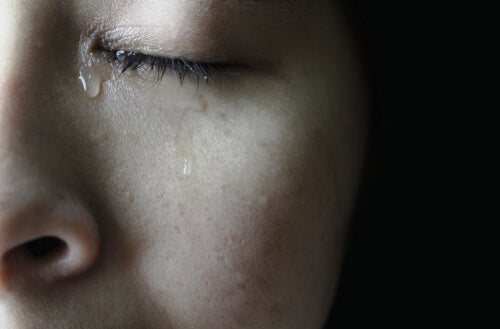Why Do People Cry Tears of Joy?

Crying is usually associated with feelings of loss, sadness, disappointment, or melancholy. Tears help us express grief, frustration, or anguish… negative emotions in general. However, there are also situations in which we cry out of happiness – this can be associated with illusion, relief, and excitement, among other emotions. Some people don’t understand it, but crying tears of joy is very likely when we’re moved by positive emotions.
Now, isn’t this way too contradictory? How can a negative expression correlate with a feeling of happiness? In the following article, you’ll discover the answer that several pieces of research have found regarding this curious phenomenon.
Crossed emotions
You cry when you’re given news you’d been waiting for a long time, when someone opens themselves to you, or when you’re surprised. There are many occasions when a happy event may lead you to react in this contradictory way.
However, crying isn’t the only external expression; you may also feel like pinching the cheeks of a sweet child or softly biting the person you love. This may also happen backward. Sometimes, in the face of extreme sadness, you might smile or begin to laugh nervously.
These reactions are automatic and have no apparent logic. However, understanding the association between positive emotions and negative expressions (and vice versa) is vital in order to fully comprehend why people cry tears of joy.

Why do people cry tears of joy?
To restore emotional balance
Oriana Aragón, a psychologist at Yale University, has conducted several studies on this matter. Under the name dimorphic expressions, her studies evaluate the presence of emotional manifestations that have nothing to do with the feeling that a person is experiencing.
This isn’t about the coexistence of a positive emotional state with a negative one. We’re referring to an emotion that, although is purely positive, adopts a “negative” expression to manifest itself. In the study Aragón conducted, she presented positive stimuli to some individuals and evaluated their way of reacting.
The results showed that those who expressed themselves through negative reactions managed to moderate the intensity of their emotions more easily. In other words, she realized that tears of joy were a way to restore balance to an overwhelming emotion. It’s as if the negative expression counteracted the intensity of the positive emotion to achieve balance.
Now, this brings an interesting question to mind. Why do people feel like putting a boundary on a feeling of fullness? Basically, feeling extremely joyful could lead some individuals to fall into a state of shock. This, consequently, clouds their ability to make assertive decisions. Restoring emotional balance is necessary to continue functioning properly.
To communicate
Moreover, tears of happiness not only have the purpose of maintaining internal homeostasis, but they’re also an important source of communication. One study found that the response people tend to offer others who express their joy by smiling or crying is significantly different. In the first case, they usually join the celebration and share the person’s exaltation with the aim of prolonging their feeling of happiness.
However, in the face of tears of joy, people tend to react in a way that helps the individual to regulate and decrease the level of emotional intensity they’re experiencing. In this case, they perceive their emotional overflow and act accordingly, contributing to downward regulation.

People cry tears of joy and bite with love
Therefore, thanks to all these studies and pieces of research, we’re able to shed light on behaviors that seem inexplicable. When you experience a positive emotion (whatever it might be) in an extreme magnitude, you’re basically forced to react in the opposite way to balance out your system.
This explains why, from time to time, someone might look at their partner and feel the need to bite them or hurt them in some way. Such a flood of love, illusion, and gratitude could overwhelm anyone to the point where they react aggressively. In conclusion, this is the way many of us compensate for these emotional peaks.
Therefore, when you find yourself reacting aggressively or sadly to highly positive experiences, don’t panic. This mechanism is completely normal and necessary. In the same way, when you see someone crying tears of joy, keep in mind that the happiness they’re experiencing is so intense that it exceeds the most natural expression of emotion.
Tears aren’t a symbol of weakness or drama. On the contrary, they’re a direct expression of the person’s great ability to feel; as well as of the emotion that the circumstances are causing in their body.
All cited sources were thoroughly reviewed by our team to ensure their quality, reliability, currency, and validity. The bibliography of this article was considered reliable and of academic or scientific accuracy.
- Aragón, O. R., Clark, M. S., Dyer, R. L., & Bargh, J. A. (2015). Dimorphous expressions of positive emotion: Displays of both care and aggression in response to cute stimuli. Psychological science, 26(3), 259-273.
- Aragón, O. R., & Clark, M. S. (2018). “Tears of joy” & “smiles of joy” prompt distinct patterns of interpersonal emotion regulation. Cognition and Emotion, 32(5), 913-940.
This text is provided for informational purposes only and does not replace consultation with a professional. If in doubt, consult your specialist.








